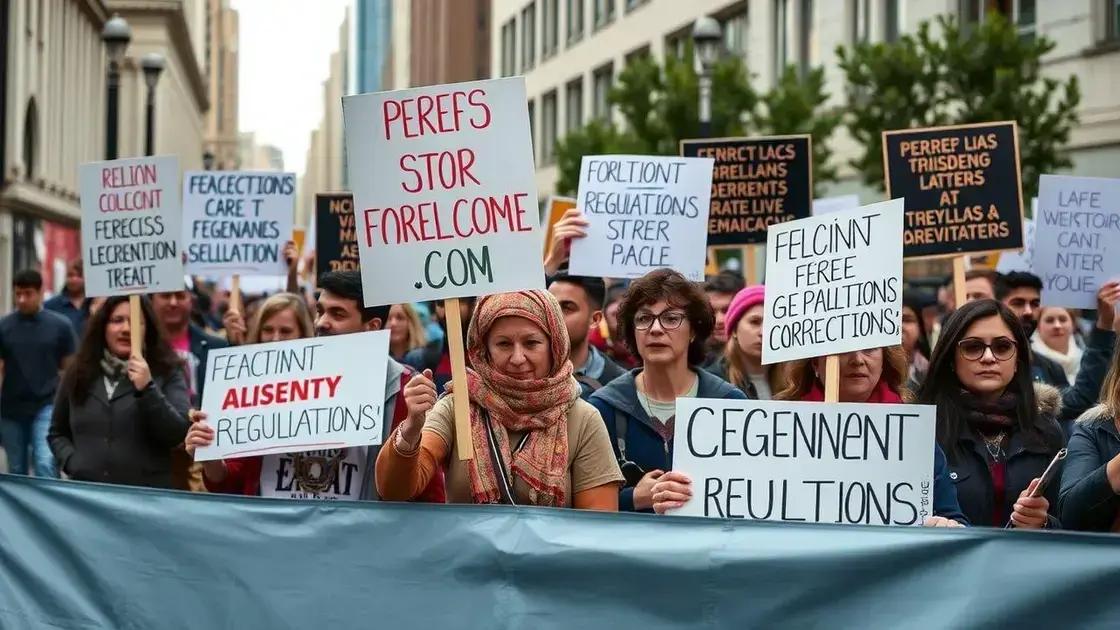Protesters rally in opposition to Trump-era regulations

Protesters rally in opposition to Trump-era regulations due to concerns over environmental degradation, public health risks, and the impact on local communities, emphasizing the need for a balance between economic growth and sustainable policies.
Protesters rally in opposition to Trump-era regulations, expressing their frustrations and fears about the implications these policies have on their lives. Have you ever wondered how such regulations influence your community and environment? In this article, we’ll delve into the reasons behind this wave of opposition.
Background of Trump-era regulations
Understanding the background of Trump-era regulations is crucial to grasping the current political landscape. These policies were designed to shift the regulatory focus, aiming for economic growth while facing criticism for potential environmental and social impacts.
Key Policies Established
During Trump’s presidency, several significant regulations were introduced. These include changes related to environmental protections, labor standards, and healthcare. Each of these areas impacted a vast number of Americans.
- Rolling back the Clean Power Plan
- Reducing restrictions on fossil fuel operations
- Altering regulations on workplace safety
- Changing healthcare policies affecting millions
These changes aimed to enhance business operations by reducing compliance costs. However, many critics argue that these deregulations could harm public health and the environment.
Communities Affected
The repercussions of these regulations were deeply felt in local communities. For instance, communities near industrial zones experienced increased pollution levels due to relaxed regulations. This led to rising health concerns, especially for vulnerable populations.
Protesters rallying against these measures highlight their fears over the long-term consequences for their health and future. The landscape of regulatory measures remains a contentious issue.
As these changes were rolled out, public response varied significantly. While some applauded the reduced regulations as a boost for the economy, others voiced serious concerns. The division among the public reflects the complexity of balancing economic growth with environmental and social responsibility.
Through examining the background of Trump-era regulations, it’s evident that these policies continue to influence debates today, shaping the dialogue around governance and accountability in the United States.
Key issues raised by protesters
The key issues raised by protesters against Trump-era regulations highlight significant concerns affecting individuals and communities. Many protesters express fear that deregulation may harm public health and the environment.
Environmental Concerns
One major issue is the impact on the environment. Relaxed regulations have led to fears about pollution and climate change. Many worry that increased emissions from industries might contribute to worsening air quality.
- Threats to clean water sources
- Increased greenhouse gas emissions
- Loss of biodiversity
- Impact on public health
In addition to environmental motives, protesters are concerned about the social implications of these policies. Communities that rely on clean air and water for their livelihood are most affected.
Impact on Public Health
The connection between these regulations and public health is also critical. Deregulation can lead to more pollutants in the air and water, posing risks to community health.
Protesters rallying in opposition often cite studies linking exposure to pollutants with serious health issues. Conditions like asthma and other respiratory illnesses can worsen in polluted environments. These concerns are especially pronounced in low-income neighborhoods where industrial activity is concentrated.
The fight against these regulations isn’t just about the environment—it’s about the health and future of entire communities. Ensuring that economic growth does not come at the expense of health is a central theme among protesters. This dynamic interplay reveals an ongoing struggle between economic policies and social responsibility.
Thus, the voices of protesters raise essential questions about the balance of progress and protection in society. Understanding these key issues raised by protesters is vital for recognizing the broader implications of regulatory changes.
Impact on local communities

The impact on local communities from Trump-era regulations is profound and multifaceted. Many residents are feeling the effects of deregulation in tangible ways, particularly in areas related to health, economy, and the environment.
Economic Changes
One significant concern is the economic impact of rolled-back regulations. While some argue that less regulation boosts local businesses, others contend that it can harm communities dependent on protective measures. For example, reduced workplace safety standards may lead to more accidents.
- Increased job hazards for workers
- Potential for economic inequality as large companies benefit more
- Disruption of local economies dependent on sustainable practices
- Risk of job losses in regulated industries
Local businesses that rely on compliance with environmental and safety regulations may struggle to compete with those benefiting from deregulation. This can create job instability and economic disparities in affected areas.
Health and Environmental Effects
The rollback of environmental protections has raised alarms within communities. Concerns about air and water quality have become more pressing as industries face fewer restrictions. Many residents fear that pollution will rise, affecting their health and quality of life.
Communities closest to industrial activities often experience the greatest impact on public health. Pollution from nearby factories can lead to increased respiratory issues and other health problems. Vulnerable populations, including children and the elderly, may be at an even higher risk.
The struggle for environmental justice plays a critical role in how communities react to these changes. Many residents feel unheard in discussions around policy changes impacting their lives. This has led to heightened activism among local groups seeking to voice their concerns.
As these dynamics unfold, it becomes clear that the impact on local communities is not just an abstract issue; it’s a daily reality for many. Understanding these changes is essential for grasping the broader social ramifications of regulatory shifts.
Responses from government officials
The responses from government officials concerning Trump-era regulations reveal a wide range of opinions and actions. Some officials defend the deregulation efforts as necessary for stimulating the economy, while others express concerns about environmental and health impacts.
Support for Deregulation
Many government officials, particularly those in the Trump administration, strongly supported deregulation. They argued that reducing restrictions would create jobs and drive economic growth. Supporters often point to:
- Lowering compliance costs for businesses
- Encouraging innovation and entrepreneurship
- Increased investment in key industries
- Boosting the overall economy
These claims appealed to various stakeholders, including business owners and certain voters seeking economic improvement. They believed that less regulation would unleash the potential of the American economy.
Criticism from Opponents
On the other hand, many government officials, including those in local and state positions, have vocally opposed these regulations. They argue that deregulation can lead to dangerous consequences for public health and safety. Concerns revolve around:
- Increased pollution levels
- Risks to worker safety
- Long-term health effects on communities
- Potential loss of biodiversity
This criticism is often backed by scientists and public health advocates who stress the importance of regulations. These officials push for a balanced approach that considers both economic concerns and the wellbeing of citizens.
The division among officials illustrates a broader debate about the role of government in regulating industry. The differing responses can significantly influence local communities, further complicating the dialogue around these issues.
As these discussions evolve, the responses from government officials will continue to shape the regulatory landscape, impacting both policy and public opinion on the matter. Understanding these viewpoints is crucial for comprehending the complexities involved in regulatory changes.
Future of environmental policies
The future of environmental policies remains uncertain as the impact of recent regulations continues to unfold. Many experts predict significant changes depending on the priorities of future administrations and public pressure.
Shifts in Policy Direction
As environmental issues gain more attention, many believe that future environmental policies may shift toward greater protection. The recent protests and public outcry against deregulation indicate a growing awareness among citizens.
- Increased focus on climate change
- Stricter regulations on emissions
- Expansion of renewable energy initiatives
- Protection of natural resources
This change could lead to a more proactive approach from government officials, who may seek to create laws that prioritize sustainability over short-term economic gains.
Public Involvement and Advocacy
Public involvement will play a crucial role in shaping the future landscape of environmental policy. As seen with recent protests, community advocacy can significantly influence legislative agendas. Grassroots movements continue to push for change, advocating for:
- Stronger environmental justice laws
- More funding for conservation efforts
- Greater transparency in industrial practices
- Community-led sustainability projects
This active engagement demonstrates a firm commitment to environmental stewardship among citizens. Their voices resonate in government discussions, making it clear that people expect action against environmental degradation.
The future of environmental policies will likely reflect a balance between economic development and environmental protection. As more communities recognize the value of preserving the environment, the policies that emerge will need to address the needs of both people and the planet.
In summary, the ongoing debate surrounding Trump-era regulations emphasizes the importance of understanding their effects on local communities and the environment. As protests indicate increasing public concern, the future of environmental policies will be shaped by the voices advocating for change. It is clear that a balance between economic growth and environmental protection is necessary for a sustainable future. By engaging in discussions and participating in activism, citizens can play a vital role in influencing policy and protecting their communities.
FAQ – Frequently Asked Questions about Trump-era Regulations and their Impact
What are the main concerns related to Trump-era regulations?
Main concerns include environmental protection, public health risks, and economic disparities affecting local communities.
How have protests influenced environmental policies?
Protests have raised awareness and demonstrated public concern, potentially pushing government officials to reconsider and strengthen regulations.
What role do local communities play in shaping future policies?
Local communities advocate for their interests, often influencing policy through activism and public engagement, highlighting health and environmental concerns.
Why is a balance between economic growth and environmental protection important?
Balancing these factors ensures sustainable development that fosters economic opportunities while safeguarding public health and the environment.






